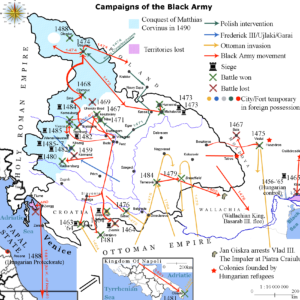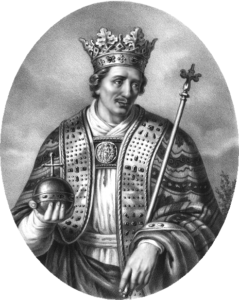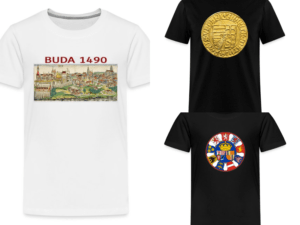King Matthias at Boroszló (Wroclaw, Breslau)

Why couldn’t Matthias fight against the Ottomans as he wished?
King Matthias Corvinus has always been criticized for not focusing his forces against the Ottomans. In fact, he tried to get hold of the power of Central Europe first, knowing that the Kingdom of Hungary would not be strong enough against the mighty Ottoman Empire. It is interesting, that later the Habsburgs wanted to do the same: saving Europe by building a Central European empire, but instead of Buda, governed from Vienna.

As for launching his great war against the Ottomans in the future, the situation of Matthias was not quite simple in 1474 because the Holy Roman Emperor allied with the Czech and the Polish kings against him, not to mention the conspiration at home which had to be put down, too.
How did Matthias beat a nine-fold bigger army at Boroszló (Wroclaw, Breslau)?

King Casimir IV (1427-1492), the Polish king had married Elisabeth, the daughter of the late Hungarian king Albert in 1454 so he had his claims for the Hungarian and the Czech thrones. King Casimir’s son, Ulászló (1456-1516) was crowned as King of Czechia in 1471, later we will see him on the Hungarian throne in 1490, after Matthias’ death: he will be called King Ulászló II. (He had two unsuccessful tries to get the throne from Matthias by force before it.)

But now, the father and his son attacked Matthias in 1474 in earnest to get the rich Silesian lands back.
Mathias, having taken care of the plots at home, hurried to Silesia with less than 10,000 seasoned mercenaries. He didn’t want to hold a grand scale battle but he has carefully designed a defensive strategy. He took good care to get hold of each fortified place that lay in the area of the possible military operations, strictly taking actions by executions and bribes if nothing else worked. He had some of the forts destroyed but left small garrisons in the strongest ones.
Knowing that Ulászló was on his way with his 20,000 men and Casimir was coming with his 60,000 soldiers, he and a couple of hundred of his troops got into the capital of Silesia, Boroszló (Wroclaw, Breslau) and next to the town he had a strong wagon-fort built, in addition to this. This city had belonged to the Czech crown since 1335, along with the biggest part of Silesia but it was owned by Matthias between 1469-1990.
The Czech and the Polish armies joined forces in October and set out towards Boroszló (Wroclaw). Despite their numbers, they were quite undermotivated and not well-supplied soldiers, mostly members of the noble insurrection. The riders of Matthias were harassing them but he let them come. The king ordered the villagers of the area taken into his forts and had all the food and forage collected, too, making the middle of Silesia an unpopulated desert. The locals in the forts had plenty of food and the Black Army kept strict discipline. You can read more about the Black Army on my page here:
https://www.hungarianottomanwars.com/essays/the-size-of-king-matthias-army/
The garrisons were ordered to harass the enemy ceaselessly with sallies. The enemy could find no food so they had to travel farther to forage but they were trapped and destroyed by Matthias’ units. At one point, Casimir took his army to the other side of the Odera River, and thus he left the Polish border unguarded. Matthias immediately sent his general, Szapolyai Imre to raid Poland.

The enemy was without advice because they couldn’t besiege all the forts as the winter was coming soon. Attacking Boroszló was not a good idea because of the strong artillery forces of Matthias, besides, their last logistic lines would have been cut in case of besieging the town. By now, these lines have been already severed, though, and the light riders of Matthias were raiding and sacking deeper and deeper in Poland without meeting any resistance.

A Serbian contingent could reach as far as Krakow, causing panic while the Hungarian raiders were pillaging the Czech territories. The enemy was hungry and cold and the bad news ruined their morale. Their units had to go for food farther and farther and they were either killed or captured, the Czech and Polish mercenaries of the Black Army even used their language skills to snare the enemy. More and more captives got thronged in Matthias’ garrisons and many of them died of starvation.

Casimir and Ulaszló’s army has been decreasing rapidly. Hundreds of wagons were seized by the Hungarians who were supposed to carry food and clothes to the enemy. In the meantime, the Hungarian king celebrated splendid feasts in Boroszló, the inhabitants of this town remember this time as one of the most remarkable periods in the history of their city.

Then, Casimir pleaded with Matthias to allow him to buy some food that Matthias had permitted him, provided the two kings pleaded with him in person. Casimir arrived at the meeting place on 15 November where Matthias was waiting for him with 3,000 men dressed in shining armor, on a hillock. As Ulaszló failed to arrive, Casimir was sent back and they had to come back together on the following day. Their request was permitted and the still outnumbering enemy was able to eat for three days.

After this, Matthias began to summon his troops and get ready to chase the enemy but Casimir and Ulaszló hadn’t waited for it and sped for home. Matthias didn’t want to push his success further and let them go. When Ulászló left his camp, he set it on fire but unfortunately, the flames spread to the Polish camp, too. According to the Treaty of Olmutz which stopped this war, Matthias agreed to share the title of the Czech king with Ulaszlo who was ruling the smaller part of Czechia / Bohemia.

Dear Readers, I can only make this content available through small donations or by selling my books or T-shirts.
If you like my writings, please feel free to support me with a coffee here:
You can check out my books on Amazon or Draft2Digital, they are available in hardcover, paperback, or ebook:
https://www.amazon.com/dp/198020490X
or at https://books2read.com/b/boYd81



My work can also be followed and supported on Patreon: Become a Patron!http://Become a Patron!


